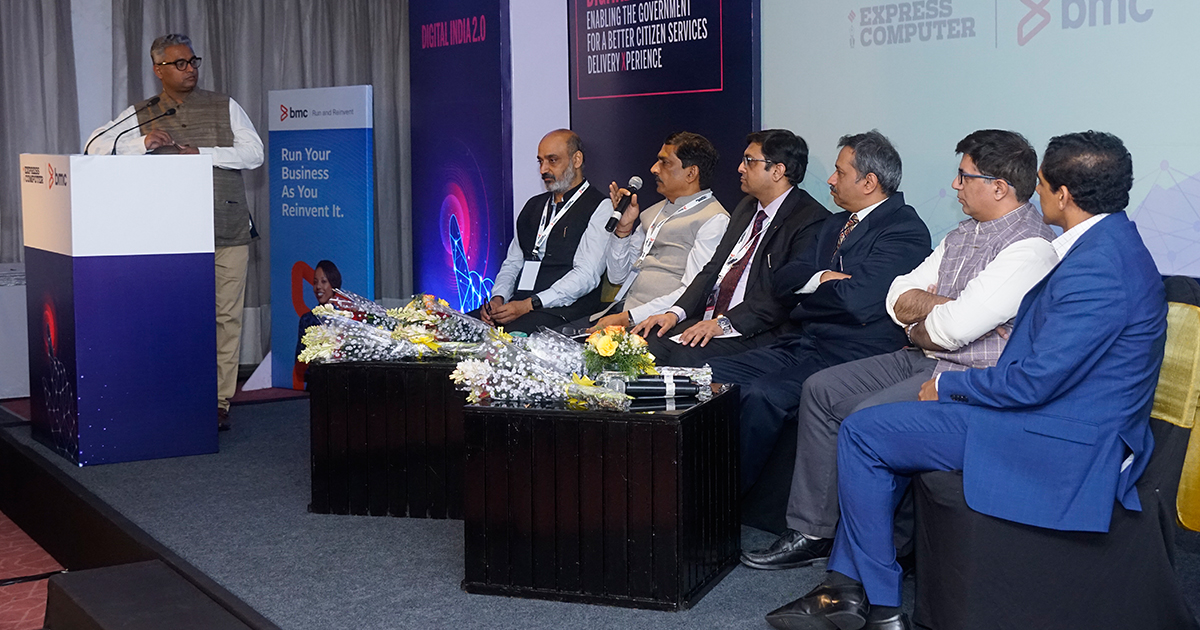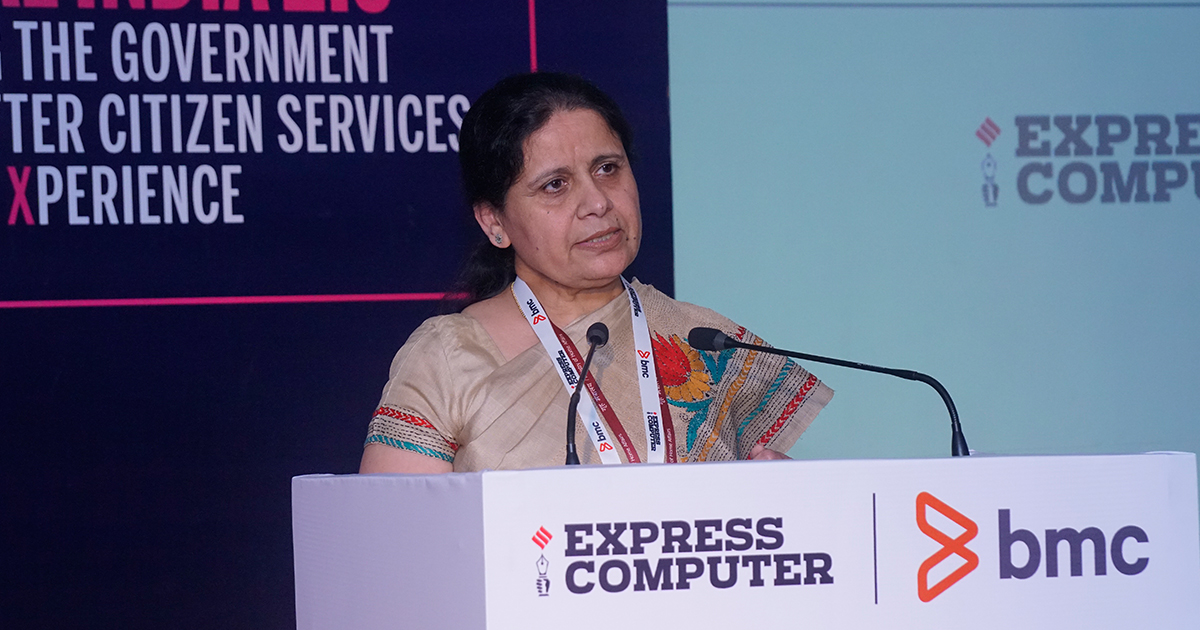Digital India 2.0: Govt transforms with emerging technologies
Express Computer collaborated with BMC Software and organised a focused conference themed 'Digital India 2.0: Enabling the government for a better citizen services delivery Xperience' on February 26 in Delhi
The Government of India is riding on a huge digital transformation path – from building apps on the public cloud to using analytics for better service delivery, every central/state department is looking to leverage the power of technology to significantly transform the way it functions or delivers service. The potential for public service delivery transformation is huge as AI has the ability to boost India’s global competitiveness and add $957 billion to India’s GDP by 2035. The conference, organised by Express Computer and BMC Software, focused on how government agencies can leverage emerging technologies like AI and ML to improve performance and delivery of digital services.
Driving government initiatives
The conference kick-started with a keynote address by Dr Neeta Verma, Director General, NIC, who spoke on the role of emerging technologies in government initiatives. She said, “Over the decades, we have engaged with various state governments, central government and district administrations for numerous initiatives, such building IT services, platforms are schemes, and service delivery to citizens at various levels. The Government of India is very ahead in terms of technology adoption. In several instance, many new technologies have been adopted by the government, much before they became mainstream in the industry. As a result, government services have also evolved with technologies. This has changed the way the government interacts with citizens and how citizens avail government services.”
She further added, “The smartphone boom has further brought another revolution in e-governance, and has brought in the concept of self-service. Mobiles have enabled new services to be more personalised and targetted in nature. However, it also brought new challeges and opportunities for the government. With widening of user base, governments, for instance, had to provide services in different languages, thereby catering to the masses. The penetration of broadband and cloud has brought another paradigm shift. Cloud has provided the concept of platforms, which has made service roll-out and delivery much more efficient. It has also enabled us to utilise our resources optimally”
NIC’s Digital Office solution has been adopted by 345 organisations, and covers around 18 state governments. Another initiative, eCourts, has connected 20,000 courts in India. These initiatives are also creating a new set of services, which were earlier non-existent. As part of Digital India 2.0, NIC has also developed a no-code platform – Service Plus, which enables configuration of services and making them live in just two days. Haryana government has recently lauched around 400 services, using this platform.
“As we add AI and ML into this platform, it will further take us to new levels. A crucial component of Digital India 2.0 is a big platform, wherein we are connecting nation-wide systems through open APIs. IoT is another technology, which can be applied in multiple areas. We are living in exciting time and there’s scope for many more innovations,” informed Dr Verma.
Government – The enabler
Another highlight was the fireside chat between R Chandrashekar, Former President, Nasscom and Srikanth RP, Group Editor, Express Computer and CRN India. Speaking broadly on the vision of a digital India, Chandrashekar said, “We have had many accomplishments. We realised that e-governance has to be a movement across the government, for it to be successful, and connect the government with citizens. The national e-governance plan has marked a transition to focus on service delivery to citizens. As part of this large national effort, some of the flagship programmes, such as CSC and Aadhaar, have become the foundation of Digital India. India has made rapid progress, compared to several other countries. This momentum has got accelerated today. Interestingly, some of the states have been ahead of the central government in terms of technology adoption. The overarching view of e-governance as an integrated programme has been a driving force. The involvement of private sector has also played an instrumental role.

Elaborating on the role of new-age technologies in the government sector, he added, “The emerging technologies such as AI, ML, augmented reality, IoT and blockchain are coming at a pace, which is much greater than our ability to adapt. There are certain characteristics of most of these technologies, which mark them a class apart. These technologies are infinitely scalable, extraordinarily powerful, and can be implemented quickly. They are also affordable and can be personalised at scale. For a country like India, all of these characteristics are important. These technologies have profound implication for the country’s growth.”
Smart governance
Sunil Kumar Thakur, Country Manager, BMC Software India conducted an insightful session on ‘Digital India 2.0 – Smart Government with AI’. He said, “Prime Minister Narendra Modi has recently said that a huge proportion of digital payments and startups come from Tier 2 and Tier 3 cities. This means that citizens from these cities will through different channels to connect with the government. In order to service these masses, we need an autonomous digital enterprise. Today, AI is no more an expensive technology; it is widely available. The advancement in machine learning and deep learning technologies has brought down the cost of storage and processing power significantly. Application of AI and ML to the existing platforms in government will make them more efficient and enhance citizen experience.”

Speaking about about BMC Helix Chatbot, Thakur said, “Most bots on websites are text-bots. However, at BMC, we have embedded AI and ML into all of our solutions. This enabled our bot to deliver a human-like interactive experience to users.” He also gave an example of George Washington University, which deployed the BMC Helix Chatbot. This is resulted in reduction in time to self-service resolution, 25 per cent self-service deflection and 11 per cent case resolution via the chatbot.
The conference also featured a panel discussion on the role of Emerging technologies in improving e-governance services. The discussion was moderated by Nivedan Prakash, Senior Assistant Editor, Express Computer and CRN India, and participated by RS Mani, DDG, NIC and Project Director, National Knowledge Network; Maj. Gen. Sandeep Sharma, National Technical Research Organization; Vikas Guru, Vice President and OSD to CEO, GeM; Madhukar Kumar Bhagat, IRS, Commissioner of Income Tax; Anurag Dua, Director, PwC; and Gunal Kannan, Area Vice President, Pre-Sales – APJ, BMC Software.

R S Mani said, “From all the initiatives we taken undertaken, we have created a huge data pool and ensuring security is key. There’s a need to have a technology in place, in order to find security threats and predict for the future. There are many areas where we need to apply technologies such as AI and ML.”
Providing interesting insights from the defence sector, Sharma informed, “When I joined the Indian Army, getting information was difficult. The challenges in front of the army are different than those faced by e-governance. However, with efforts by the armed forces and the government, things have improved exponentially. For instance, we are now the second largest holder of OFC in the country. We have further streamlined our processes through initiatives such as Armaan.”
Guru explained in detail the various initiatives undertaken by GeM. He said, “We have an advantage of being a late mover in this technology era. We are already using most of these transformational technologies. For instance, the GeM platform is hosted on the Government Community Cloud (GCC). We are also using APIs for real-time authentication with government databases.” Similarly, Bhagat explained the flagship Aadhaar based instant PAN application initiative. Dua was of the opinion that India has witnessed a leapfrog in terms of technology adoption in the public sector, and cited numerous use cases and examples from the government space.
Kannan added, “We aide government organisations with not just products, but innovations. We have been in the market for more than 40 years and have over 470 patents. We are envisioning future organisations to be more autonomous. Our focus is also around governance compliance and security, because as data explodes, security becomes a greater concern.”

